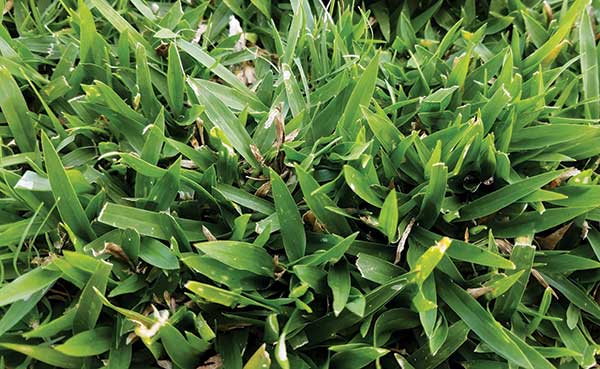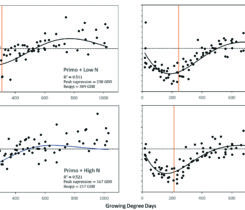Experts’ Insights: Tamping down tropical signalgrass

Tropical signalgrass can be spotted by its signal-flag-like seedhead. (Photo: FMC Professional Solutions)
The most identifiable feature of tropical signalgrass is the seedhead, which is where the perennial weed gets its name because it looks like an old signal flag on ships, according to Bryan Unruh, Ph.D., professor and associate center director at the University of Florida.
“Most of the time, golf course superintendents are mowing this thing off, and so it never produces those seedheads, and if it does, they stay low to the canopy,” Unruh says. “It’s mat forming and will form this mass and choke everything else out.”
He adds that tropical signalgrass produces above-ground stems or stolons, the leaf blades often have a sheen to them and there are hairs on the leaf blade and leaf sheath.
It emerges later than crabgrass and goosegrass — in late spring and early summer.
“It’s a perennial so it can live pretty much year-round, and it tends to be later, which is part of the reason it’s problematic because we tend to be focusing on crabgrass and goosegrass for our spring preemergent products, and we miss that tropical signalgrass (window),” Unruh says.
From a cultural standpoint, superintendents should grow healthy turf and implement practices such as verticutting, aerification, fertilizing and irrigating. “The base grass, whether it’s bermudagrass or seashore paspalum, should be as healthy as can be,” he says.
Unruh adds that fall is the optimum time for more effective long-term control.
“The seed germinates in the spring later than crabgrass and goosegrass, but that starts a whole new cycle of the plant,” he says. “Once that seed is germinated, that plant can live in perpetuity. If you have the plant out there, you try to minimize the emergence through preemergent strategies and effectively control it with postemergent strategies, and that’s where most of the research points to fall applications being the ideal approach.”

Tina Bond (Photo: FMC Professional Solutions)
FMC Professional Solutions
Tina Bond, Ph.D.
Technical service manager
Tropical signalgrass (TSG) seed germination occurs in soils with a pH of 5 to 6 when soil temperatures reach 77 degrees F. Preemergent herbicides should be applied under these environmental conditions. Herbicides containing indaziflam or prodiamine will aid in preemergent control of TSG. For postemergent TSG control in bermudagrass, herbicides containing amicarbazone (two applications at 10-14.5 fl oz/acre on 14-day intervals) or sulfentrazone + imazethapyr (two applications at 7.0-8.0 oz./acre on 14-day intervals) can be used alone, in rotation with other herbicide groups or as a tank-mix partner depending on label recommendations. Fall application timing provides the most effective control of TSG. Regardless of which herbicide is used, multiple applications will be necessary for adequate control. An integrated management plan is necessary for optimal control of TSG. Mapping infestations, verticutting, cleaning mowers of debris, recording spray applications and other cultural practices should be used when managing TSG.

Lane Tredway (Photo: Syngenta)
Syngenta
Lane Tredway, Ph.D.
Technical services manager
The first step in managing tropical signalgrass is to encourage dense, healthy turf that can outcompete weed encroachment. Certain preemergent herbicides can inhibit germination for up to eight weeks, but tropical signalgrass germination occurs over a six- to 10-month period in Florida. It can be difficult to maintain consistent preemergent protection over this prolonged time frame. Once tropical signalgrass becomes established, postemergent control with the active ingredient of pinoxaden is a great option. Two applications on 14- to 21-day intervals are recommended. This type of herbicide has two major advantages: It performs well in the summer and has excellent safety to bermudagrass and zoysiagrass, so superintendents can control tropical signalgrass when desirable turf has the greatest chance to reestablish.

Erich Slider (Photo: SiteOne)
SiteOne
Erich Slider
Director of golf, South Division
Tropical signalgrass (TSG) is a challenging issue for turf managers in regions where soil temperatures stay warm and frost doesn’t develop. Spot control with selective herbicides can help keep this weed at bay. Best practices like keeping a record of treatment dates/locations can enhance the effectiveness of herbicide applications. The first step in controlling TSG is to accurately identify it. Per Todd Lowe (former USGA agronomist), “Crabgrass has a seedhead that has several stalks emanating from a single point and appears much like a hand. Signalgrass, however, derives its name from the fact that the seed stalks occur at 90 degree angles and resemble signal flags.” A postemergent approach is most effective and affordable in the fall; however, spring and summer spot control with postemergent herbicides are also effective.












